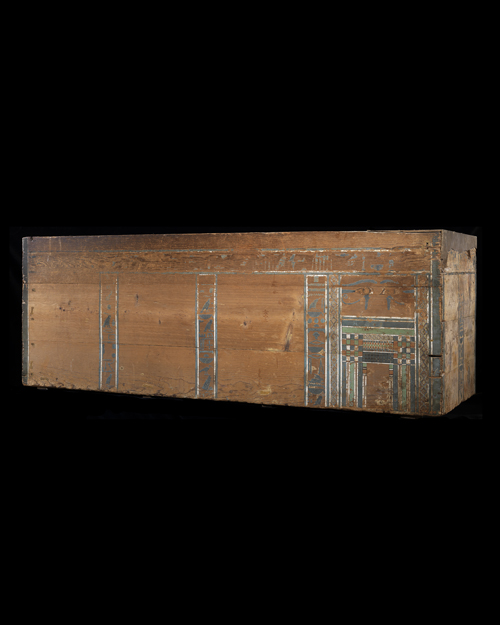
© 2008 Musée du Louvre / Georges Poncet
Deir el-Bersheh, outer courtyard of tomb n°2, shaft 15
Middle Kingdom, 12th dynasty, reigns of Sesostris II and III,
1866-1843 BC
Painted wood
H.: 95.8 cm; W.: 2.70 m; D.: 93.3 cm
Department of Egyptian Antiquities, Musée du Louvre
(E 10779 A)
Sepi, an intendant in the entourage of a nomarch named Djehutyhotep, was buried in one of the three shafts sunk in the outer courtyard of Djehutyhotep’s tomb. He was laid in two rectangular caskets, preserved at the Louvre. The front side was decorated with udjat eyes, symbolizing physical integrity, above a false door, a feature that symbolized passage and communication between the world of the living and the world of the dead. On the large outer sides, texts allude to the deceased’s departure for heaven. The formula of Nut on the front explains that the goddess has stretched herself above the deceased so that he may become a god and defeat his enemies, while the formula to Thot on the rear panel indicates that the deceased, with the aid of the god, is leaving to rejoin the gods in heaven. On the small sides Nut declares that she placed Isis at the feet of the deceased and Nephthys at his head.
The inside is richly decorated. Below a horizontal line of inscriptions (on the long sides) are two registers of friezes of objects placed on small tables; duly named, they are simultaneously depictions of funerary equipment and the evocation of rituals performed during the funeral—their presence on the sides of the coffin meant that they were eternally repeated, helping the deceased to survive in the Beyond. The space below that is entirely devoted to columns of the Coffin Texts. Finally, a feature found almost exclusively on coffins from the necropolis of Deir el-Bersheh, The Book of Two Ways is depicted on the bottom of the coffin. This set of panels and texts constitutes the first known attempt to map a geographical space that stems from an imaginary landscape. Although conceptual, it is conceived as real space through which the deceased can orient himself and move freely.